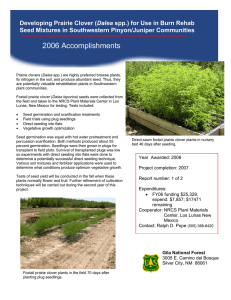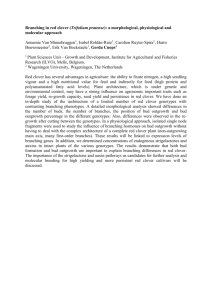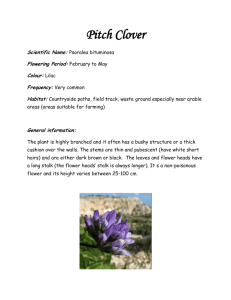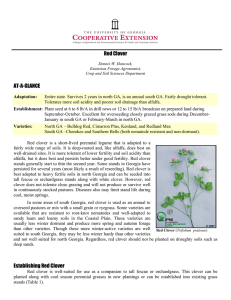by AGLICULTUPAL EXPERfNT STATION Nerch 1944
advertisement
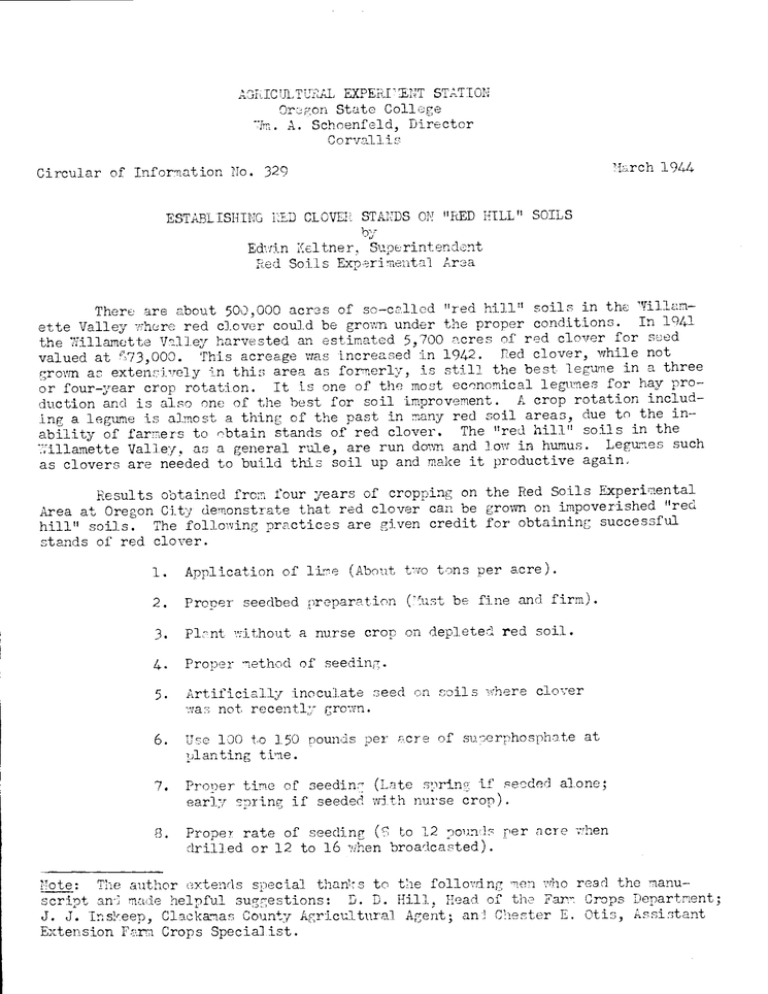
AGLICULTUPAL EXPERfNT STATION Oregorì State College 1m. A. Schoenfeld, Director Corvallis Nerch 1944 Circular of Information No. 329 ESTABLISHING NED CLOVEN STANDS ON "RED HILL" SOILS by Edwin Keitner, Superintendent Red Soils Experimental Area soils in the Til1amThere are about 500,000 acres of so-cllod 'red hifl ette Valley whore red clover could be grown under the proper conditions. In 1241 the Vil1amette Valley harvested an estimated 5,700 acres of red clover for seed valued at i73,000. This acreage was increased in 1942. Red clover, while not grown as extensively in this area as formerly, is still the best leguirie in a three or four-year crop rotation. It is one of the most economical legumes for hay production and is also one of the best for soil improvement. A crop rotation including a legume is almost a thing of the past in many red soil areas, due to the inThe "red hill" soils in the ability of farmers to obtain stands of red clover. llhlamette Valley, as a general rule, are run down and low in humus. Legumes such as clovers are needed to build this soil up and make it productive again Results obtained from four years of cropping on the Red Soils Experimental Area at Oregon C1t7 demonstrate that red clover can be grown on impoverished 'red The following practices are given credit for obtaining successful hill" soils. stands of red clover. 1. Application of hoe (About two tons per acre). 2. Proper seedbed preparation (Nust be f:Lne and firm). 3. Plant without a nurse crop on depleted red soil. 4. Proner method of seeding. 5. Artificially inoculate seed on soils where clover wa-; not recently grown. 6. .. 0. Use 100 to 150 nounds per acre of suserphospha te at plantlng time. Proper time of seedinr- (Late sprine if seeded alone; early enrang if seeded with nurse crop). Proper rate of seeding (C o 12 pounds per acre when drilled or 12 to 16 when broadcasted). The author extends special thariis to the follovdng men who resd the manuscript and mode helpful suggestions: B. B. Hill, Head of the Farm Crops Department; J. J. Tniskeep, Clackamas County Agricultural Agent; an: Chester E. Otis, Assistant Extension Form Crops Specialist. Note: Application of Lime Experimental plantLngs since the spring of 1940 have demonstrated clearly that lime nay be considered the first essential for growing red clover on rundown ith lime nearly perfect stands and good yields of red clover 'red hill!t soils. have been obtained on ground where clover had not been grown for forty years, and where many doubted the advisability of plantino clover until the fertility of the soil had been Improved. The first experimental seedings of red clover were made May 15, 191+0 on a range of thirty-three one-twent;ieth--acre plots receiving an application of two tons of 1me per acre. Over a two-year pex:od an unlined plot in this range averaged 1.6 tone of clover hay per acre, while the adjacent check plot which was limed averaged 3.1 tons per acre for the two years. All unlined plots have shown a If you are in doubt about the heavy weed growth in comparison to the limed plots. use of line on your ground, take a dried soi sample to your county agent, who will test it for lime repuirement arid make recoranenThtions as to the rate of application. Propsr Seedbed Prretion Red clover like other small seed crops needs a good seedbed, fine and firm. Lack of a good seedhed is ressoneible fo many failures to obtain a stand. Fall or winter ploring is best where conditions permlt. After the ground is worked down the so1L should be cultivtsd just often and. deem enough to destroy newly Needless working of soil permits moisture to germinated weeds as. theTr appear. The use of a homemade clod masher and packer described in Oregon Station escape. Circular of Information No, 330 is given equal credit along with the application of line for the successful stands of red clover on the Red Soils Experimental Area This packer has been used snccessfulIy in the final when planted alone in May. preparation to firm the seedbed beneath the surface and to smooth and form a fine A loose seedbed which results in too deep a coverage of the seed is a mulch, common practice by the average farmer. Then early sprin: seedings are made with a nurse crop fall plowing is essential. The field shou7d be left rough to orevent erosion. Due to the excess moisture available at this time of the year it is not necessary to pack the seedbed as firm as for the later seedings. Plantino Tithout a Nurse Crop on Depleted Soil The first succesefu] stands (f red clover at the Red Soils Experimental If clover stands Area were obtained by planting alone about the middle of May. However, are to be successful on poor red soils they should be planted alone. successful, stands of red u]over have been obtained by spring plantings when seeded red soil after the fertility has been imwith a nurse crop of grain on vrorn. Planting red clover with a nurse crop is a con on nractice which results proved. tn clover failures. This is especially true on poor soils where the more rapidly growing nurse crop of grein always has the advantage. 3 Proper Method of Seeding Late spring seedings have been succes3ful on the Red Soils Experimental Area The lower enof the when using a double-disk drill with a grass-seed attachment. seed tubes were disconnected and left hanging loose against the frame of the drill in front of the discs which were lowered to the ground when seeding was started. After seeding the corrugated roller was used to finish covering the seed. If seedings are made with a nurse crop early in the spring the method deRolling will not be necessary as the drill scribed above has proved successful. disks which have been lowered into the ground for seeding the nurse crop will cover the clover seed sufficiently. The method used in seeding the clover seed will, have a great deal to do with the securing of a good stand. The clover seed should be in contact with the moisture and at a very shallow depth--not over one-fourth inch. Many stands are lost because of planting too deep. Inoculation of Seed On the red soils in the Willamette Valler it is usually desirable to inoculate with artificial inoculant. The depleted soils which have not been growing clover normally will not contain sufficient of the clover bacteria to inoculate the new seeding. Tithout this inoculation the growth of the clover will be unsatisfactory. Fresh inoculant may be had either from your county agent or directly from the Bacteriolo,r Department, Oregon State College. Satisfactory inoculation may also be supplied by comnercial cultures if the material is fresh. Application of Phosphates Red clover, in common with other legumes, is a heavy user of phosphorus. Unless adequate supplies of phosphates are available the growth of red clover will As much of the phosphorus of the clover plant is found in not be satisf'actory the seed this material is essential for seed production. It is desirAs a general rule red soils are low in available phosphates. able that 100 to 150 pounds per acre of superphosphate be added, especially if a seed crop is to be harvested. Phosphates should be applied at planting time with a fertilizer attachment which will leave the seed and phosphates in direct contact if the best results are to be obtained. If the phosphates are broadcast just prior to seeding the rate of application should be doubled. Proper Time of Seeding Spring seedings here on the experimental area have been the most successful. Ralative late spring. seedings are best when planting red dover alone, as this gives an opportunity to control the weeds before planting time. Seedings can be made from early May to the middle of June, or even up to the first of July where there is plenty of moisture. If plantings are made with a nurse crop they should To date, fall seedbe as early in the spring as moisture conditions will permit. ings have not been successful on the experimental area. 4 Proper Rate Eight to 12 pounds of red clover seed per acre when seeding with a drill and 12 to 16 pounds when broadcasting by hand will give a good stand under ordinary good deal of time and money conditions. If the proper procedure has been followed a This investment can best be protected by using has been expended by seeding time. plenty of seed.
